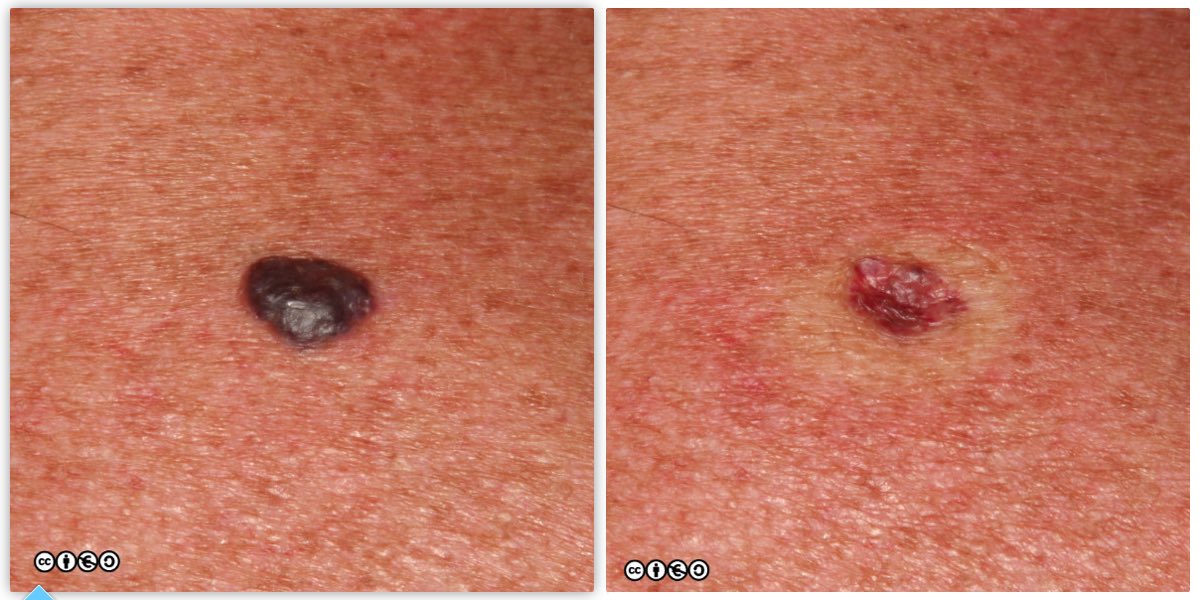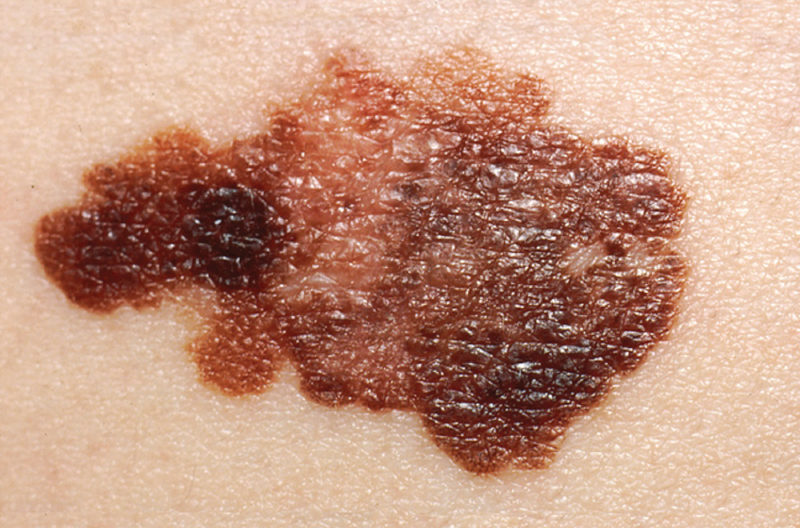Skin cancer is one of the most common types of cancer worldwide, and melanoma, often abbreviated as MM, is among its most serious forms. While melanoma accounts for a smaller percentage of skin cancer cases compared to other types like basal cell carcinoma and squamous cell carcinoma, it is responsible for the majority of skin cancer-related deaths. This article provides an in-depth look at melanoma, including its overview, risk factors, symptoms, and available treatments.

Overview of Melanoma
Melanoma is a type of cancer that originates in the cells responsible for producing melanin, the pigment that gives color to the skin. These cells, known as melanocytes, are found in the skin, eyes, and even internal organs. When these cells grow uncontrollably, they can form malignant tumors, which may spread to other parts of the body if not treated early.
Melanoma often begins on the surface of the skin but has the potential to invade deeper layers and metastasize to lymph nodes and distant organs. Unlike other forms of skin cancer, melanoma is more likely to spread and become life-threatening, making early detection critical for successful treatment.
Types of Melanoma
- Superficial Spreading Melanoma: The most common type, often appearing as a flat or slightly raised lesion with irregular borders.
- Nodular Melanoma: A more aggressive form that grows vertically into the skin and appears as a raised bump.
- Lentigo Maligna Melanoma: Typically occurs in older adults and develops in areas exposed to the sun over long periods.
- Acral Lentiginous Melanoma: Found on the palms of the hands, soles of the feet, or under the nails, and is more common in people with darker skin tones.
Risk Factors for Melanoma
Understanding the risk factors associated with melanoma can help individuals take preventive measures and seek medical attention when necessary. While some risk factors are beyond control, others can be managed through lifestyle changes.
Uncontrollable Risk Factors
- Fair Skin: People with lighter skin tones have less melanin, which provides natural protection against harmful ultraviolet rays.
- Family History: Individuals with a close relative diagnosed with melanoma are at a higher risk of developing the disease.
- Personal History of Skin Cancer: A previous diagnosis of melanoma or other types of skin cancer increases the likelihood of recurrence.
- Age: While melanoma can occur at any age, the risk increases as people grow older.
- Genetic Mutations: Certain inherited genetic conditions, such as xeroderma pigmentosum, predispose individuals to melanoma.
Controllable Risk Factors
- Excessive Sun Exposure: Prolonged exposure to ultraviolet radiation from the sun is a leading cause of melanoma.
- Tanning Beds: The use of artificial tanning devices significantly increases the risk of developing melanoma.
- Sunburns: A history of severe sunburns, especially during childhood, raises the risk of melanoma later in life.
- Inadequate Sun Protection: Failing to use sunscreen, wear protective clothing, or avoid peak sunlight hours contributes to increased risk.
Symptoms of Melanoma
Melanoma often presents as a new or changing mole or spot on the skin. Recognizing the signs early can lead to prompt diagnosis and treatment. Dermatologists recommend using the ABCDE method to evaluate suspicious moles or lesions:
The ABCDE Method
- A – Asymmetry: One half of the mole or lesion does not match the other half.
- B – Border: The edges are irregular, ragged, notched, or blurred.
- C – Color: The color is uneven and may include shades of brown, black, pink, red, white, or blue.
- D – Diameter: The spot is larger than six millimeters across, about the size of a pencil eraser, although melanomas can sometimes be smaller.
- E – Evolving: The mole or lesion changes in size, shape, color, or elevation over time.
In addition to the ABCDE criteria, other warning signs include itching, bleeding, or crusting of a mole or lesion. Melanoma can also develop in areas not exposed to the sun, such as the scalp, nails, or mucous membranes, making regular self-examinations essential.
Treatments for Melanoma
The treatment options for melanoma depend on the stage of the disease, the location of the tumor, and the patient’s overall health. Early-stage melanoma is highly treatable, while advanced stages may require more aggressive therapies.
Surgical Treatment
Surgery is the primary treatment for early-stage melanoma. The goal is to remove the cancerous tissue along with a margin of healthy skin to ensure complete removal. Types of surgical procedures include:
- Excisional Surgery: The entire tumor is removed along with a surrounding border of normal skin.
- Mohs Surgery: A specialized technique where thin layers of skin are removed and examined until no cancer cells remain.
- Lymph Node Biopsy: If melanoma has spread to nearby lymph nodes, a biopsy may be performed to determine the extent of the disease.
Radiation Therapy
Radiation therapy uses high-energy beams to target and destroy cancer cells. It is typically used in cases where surgery is not an option or to reduce the risk of recurrence after surgery. Radiation may also be employed to relieve symptoms in advanced melanoma cases.
Immunotherapy
Immunotherapy harnesses the body’s immune system to fight melanoma. Drugs known as immune checkpoint inhibitors block proteins that prevent immune cells from attacking cancer cells. Common immunotherapy medications include:
- Pembrolizumab
- Nivolumab
- Ipilimumab
These treatments have shown promising results in extending survival rates for patients with advanced melanoma.
Targeted Therapy
Targeted therapy involves drugs that specifically attack cancer cells with certain genetic mutations. For example, BRAF inhibitors are effective in treating melanomas with mutations in the BRAF gene. Examples of targeted therapy drugs include:
- Vemurafenib
- Dabrafenib
- Trametinib
Chemotherapy
Chemotherapy uses drugs to kill cancer cells throughout the body. While it is less commonly used for melanoma today due to advancements in immunotherapy and targeted therapy, it may still be an option for some patients.
Clinical Trials
For patients with advanced melanoma or those who do not respond to standard treatments, participation in clinical trials may offer access to cutting-edge therapies. These trials test new drugs, combinations of treatments, or innovative approaches to managing melanoma.
Preventive Measures
While not all cases of melanoma can be prevented, adopting certain habits can significantly reduce the risk of developing this disease:
- Avoid excessive sun exposure, especially between 10 a.m. and 4 p.m., when ultraviolet rays are strongest.
- Use broad-spectrum sunscreen with an SPF of 30 or higher, and reapply every two hours or after swimming or sweating.
- Wear protective clothing, such as wide-brimmed hats, sunglasses, and long sleeves, when outdoors.
- Avoid tanning beds and sunlamps, which emit harmful ultraviolet radiation.
- Perform regular self-examinations of the skin and consult a dermatologist for annual professional skin checks.
Living with Melanoma
A diagnosis of melanoma can be overwhelming, but many resources are available to support patients and their families. Support groups, counseling services, and educational materials can help individuals cope with the emotional and physical challenges of living with melanoma. Additionally, staying informed about the latest research and treatment options empowers patients to make well-informed decisions about their care.





